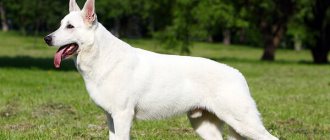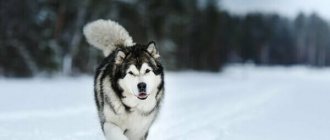The German Shepherd is a large service dog.
And every owner of a puppy of this breed is interested in whether his shepherd dog is growing and developing correctly.
Moreover, at exhibitions and training grounds, the dog owner can see his pet’s peers, who may be very different from his dog in height and physical development.
How much should a German Shepherd puppy weigh at each stage of its development and what weight and height will it have when it grows up?
What weight should an adult German Shepherd have depending on gender?
The weight of an adult male German Shepherd should be 30-40 kg, and that of a female – 22-32 kg . But there are also much larger and heavier individuals: for example, a male German Shepherd can weigh up to 50, and a female up to 35 kg.
A dog usually weighs from 23 to 38 kg per year. Starting from this age, its growth practically stops, but the dog continues to grow in width until the age of three: that is, it becomes more powerful and gains muscle mass.
A two-year-old shepherd weighs 23-40 kg and is already an almost fully formed adult animal..
From two to three years of age, the increase in body weight is insignificant, but by this age the dog should weigh, on average, 90 times more than it weighed at birth.
That is, a dog born with a body weight of 350 g should weigh about 31-32 kg at 3 years . And a dog that weighed 500 g at birth should weigh 45 kg by the age of three.
However, dogs may develop pathologies that impair development. Then the pet will grow less than normal.
What does a purebred German look like?
German dogs of pure blood have a developed muscular corset , a dry skeletal system and are of average height and straight paws. The coat color varies from black to brown with various patches. Dogs come in long-haired and short-haired varieties. The muzzle is cone-shaped, strong, the jaws are powerful, the eyes are small.
Dimensions according to standard
According to the breed standard , the height of a German Shepherd depending on gender should be :
- Males: 60-65 cm at the withers.
- Bitches: 55-60 cm at the withers.
At the same time, the body length in boys of this breed is 71-77 cm, and in girls - 61-70 cm.
The chest circumference of a German Shepherd is 83-87 cm in males and 77-82 cm in females.
Expert opinion
Tolkachev Andrey Mikhailovich
veterinarian
“The health of a German Shepherd and its working qualities depend not least on the weight of the dog. If a shepherd is overfed, its performance and endurance are greatly reduced. Underfeeding and too little weight are also harmful for representatives of this breed, since in this case the shepherd’s resistance to disease decreases. The weight and size of the German Shepherd must be within the standard and be harmonious in relation to each other.”
Head of a purebred dog
The head of a German Shepherd resembles that of a wolf. Large erect ears, an elongated muzzle of a shepherd like a forest predator. At the same time, males and females differ in the expression of their muzzle. The male dog has an imperious and courageous look, like the leader of a pack. Bitches have a more gentle facial expression.
According to the standard, the skull of a purebred dog has the same length and width. The ratio of the length of the skull to the muzzle is 1:1. The main parameter is the parallelism of the facial and cranial axes. If you place one palm along the muzzle and the other on the dog's brow ridges, then the palms should be parallel.
Shepherd eyes
The dog's eyes have a semi-lateral position and are dark in color according to the standard. The darker the eyes, the better. But only dogs with yellow eyes are rejected, as it makes the expression of the muzzle cold and distrustful.
Ears
Prick ears are wide at the base, pointed at the top, and set high on the skull. Puppies have drooping ears and can stand up from 4 to 8 months, and this is not a matter of concern. It's worse if the baby starts holding his ears too early. This indicates a weak animal whose ears are too light.
Teeth
The animal must have a full set of teeth and a scissor bite. An overbite, underbite or overbite is rejected. Dogs with partial teeth are also eliminated.
Weight and dimensions of a newborn puppy
On average, the weight of a newborn male is 500 g, females are born weighing from 350 g . But this is the average litter size of 6-8 puppies.
If a small number of shepherd puppies were born - 3-4, then their weight, regardless of gender, will be equal to 450-500 g. In a large litter, from 8 to 12 puppies, it, also regardless of the gender of the babies born, will be slightly smaller and will be approximately 350-450 g.
The length of newborn German Shepherd puppies is 18-22 cm.
Violations in the breed standard
A German Shepherd may have appearance faults that are considered serious but do not lead to immediate disqualification. These include:
- incorrect pigmentation;
- deviations in the structure of the dental system. This is an incorrect bite (different from a scissor bite), a lack of certain dental units (however, this does not apply to all teeth);
- visible deviations from the standard strong constitution of the German Shepherd;
- defects associated with the ears. For example, excessive or insufficiently high landing of the ears on the head, non-pointed tips or ears directed at each other.
In addition to serious deficiencies, a German Shepherd may exhibit defects that lead to immediate disqualification.
So, disqualifying defects in appearance and character include:
- height is more than one centimeter above or below the standard;
- excitable nervous system, weakness of temperament, biting;
- deformations of the ears and tail;
- the presence of developmental defects;
- albinism;
- white “shirt” on the wool. Even in combination with dark corneas and claws, this sign is a defect;
- very long topcoat hair that does not fit well to the body;
- soft fur, feathering behind the ears, excessively fluffy “pants”, tail with a dewlap;
- lack of undercoat, appearance of a parting in the middle of the German's back;
- absence of certain dental units;
- the presence of defects in the development of the jaws;
- malformations of the testes in males, namely their failure to descend into the scrotum. The pathology is called cryptorchidism.
Puppy weight and sizes for male and female by month from 1 to 12 months (table)
| Age by month | Height at withers for males (cm) | Height at withers in bitches (cm) | Weight for males (g) | Weight in bitches (g) |
| 1 month | 20-21 | 19-20 | 3.500-4.200 | 3.000-3.300 |
| 2 months | 35-38 | 32-35 | 8.500-9.000 | 7.500-8.000 |
| 3 months | 44-48 | 40-44 | 14.000-14.200 | 12.000-12.300 |
| 4 months | 52-57 | 47-52 | 19.000-20.000 | 16.000-16.400 |
| 5 months | 54-58 | 51-54 | 22.000-22.900 | 20.000-21.700 |
| 6 months | 56-60 | 52-56 | 24.000-26.000 | 22.500-23.000 |
| 7 months | 57-61 | 53-57 | 28.000-28.400 | 23.000-24.700 |
| 8 months | 57-61 | 53-57 | 29.000-30.000 | 25.000-25.200 |
| 9 months | 57-61 | 53-57 | 30.500-32.000 | 26.100-26.500 |
| 10 months | 58-62 | 54-58 | 32.900-33.300 | 27.000-27.500 |
| 11 months | 58-62 | 54-58 | 33.000-33.500 | 28.000-29.000 |
| 12 months | 59-63 | 55-59 | 33.000-34.000 | 30.000-32.000 |
To what age do they grow?
The most intensive growth of a German Shepherd puppy occurs in the first month of life. By the tenth day of life, the weight of babies doubles, so that the weight of males reaches 1 kg, and girls at this age weigh approximately 800 g.
NOTE!
Further growth occurs no less quickly: by the 18th day, shepherd puppies, depending on gender, weigh from 1.8 to 2 kg, and by a month they already weigh 3-3.5 kg.
Later, between two and six months, weight gain slows down.
From 1 to 2 months, the German Shepherd's weight doubles again, but further weight gain does not occur as quickly. But by the age of six months, the puppy already weighs approximately 2/3 of the weight of an adult dog.
The growth of a German Shepherd continues on average for up to a year, and puppies grow fastest until they are six months old.
During the first five months of life, puppies grow by about 10 cm every month, so that by this age their height is already 51-58 cm. From 5 to 6 months, the dog’s growth slows down sharply and the dog grows by about 3 cm per month.
By the age of 10-12 months, the German Shepherd almost reaches its maximum height and practically no longer grows in height..
But at the same time, after 1 year, a dog of this breed still continues to gain muscle mass and increase weight, and this continues until approximately the age of three.
In order for the pet to grow and develop correctly, it is very important to avoid early matings, not only in females, but also in males, since after this the animal’s growth stops very quickly.
Some owners, afraid that their dog will grow too large and therefore not meet the requirements of the standard, deliberately try to untie him as soon as possible.
This should not be done under any circumstances, since after early matings not only the dog’s growth slows down, but also its overall physical and mental development..
The growth of bitches also slows down after the first heat. This does not mean that the dog will now not be able to reach the required height before 12 months, but its growth will now not occur as quickly as in the first months of the puppy’s life.
Education and training
As mentioned above, German Shepherds are intelligent and easy to train animals. But raising a large dog should never be left to chance. From the first months of life, in the form of interesting games and tasks, the completion of which is accompanied by receiving treats, the puppy receives an understanding of acceptable norms of behavior and important commands.
German Shepherd with a child
The owner should demonstrate his authority without resorting to shouting and, especially, physical force. If it seems to you that there are significant deviations in the puppy’s behavior that you cannot cope with yourself, be sure to seek help from a canine specialist.
Of course, not every German Shepherd becomes a service dog and maintains order in special units. But even a pet needs to understand and respond adequately to basic commands: “Come to me!”, “Place!”, “You can’t!”, “Nearby!”, “Sit!”, “Lie down!”, “Walk!”, “ Aport!
When the puppy’s bones are strong enough, you can begin to overcome obstacles (be sure to take into account the height and capabilities of the pet). The most important point is to teach the dog to walk on a leash, and from six months - in a muzzle. It’s better to do this gradually and don’t forget about tasty rewards for obedience.
It is important to remember that German Shepherds reach psychological maturity quite late, by the age of three. A young dog, whose dimensions fully correspond to the breed standard, internally remains a vulnerable puppy, requiring care and approval.
The influence of various factors on the pet’s parameters
A variety of factors can influence a puppy's height and weight, such as:
- Heredity . Dogs of some lines grow larger, while others grow smaller in size. In addition, the rate of height and weight gain may also depend on heredity.
- Intrauterine development . If the puppy’s mother ate properly during pregnancy and was kept in good conditions, then her babies received all the vitamins and minerals they needed. They gained good weight and height at the time of birth, and therefore had all the makings for normal physical development.
- Sucking period . The conditions for keeping and feeding babies in the breeder’s home are very important. If the lactating bitch ate well, and the puppies were started on time and fed correctly, then by the time of activation and subsequent sale they will have good height and weight, and their psychological and physical development will be appropriate for their age.
- Quality of feeding. Often, lack of height or weight in dogs is due to the fact that the dog is malnourished, which is why it regularly does not get the vitamins, microelements and other nutrients it needs.
- Content. If a German Shepherd puppy is constantly sitting in an enclosure or on a chain and is not being handled, trained or walked, then it simply will not have the opportunity to develop physically. The same applies to city dogs, which are kept in apartments and taken outside only for a few minutes a day.
- Diseases. If a puppy or young dog has suffered from a serious infectious disease, its growth may be stunted or even stop completely. The presence of internal parasites can also negatively affect a dog’s height and weight.
In order for a shepherd puppy to grow up strong and healthy, so that it does not suffer from infections due to which it may subsequently stop growing, it is necessary to give it all the necessary vaccinations on time and protect it from contact with sick animals.
Show dog and its condition
Having got an ideal pedigree dog, you may not get a good mark at the show. Education and training are only one part of the job. The dog must have the correct constitution, that is, normal grooming and fatness. A well-fed pedigree dog will not receive a good grade, just like an emaciated one. The condition of a pedigree dog, as a rule, differs from this indicator of an animal of working breeding. The latter may have a thinner layer of fat. Working dogs are not assessed by conformation at all, since their success in competitions is important. They are used to evaluate the dogs in this ring.
The two branches of dogs have been bred since the time when the kennel owners themselves split. Some focused on beauty, others on reaction speed and endurance. At the same time, pedigree dogs still did not become decorative sissies.
What to do if it lags behind the norm
First of all, do not worry if we are talking about a puppy or a young dog that has not reached the age of three, and its weight loss does not exceed 10-15%.
The fact is that all dogs develop differently, and a shepherd dog that is still growing may experience slight weight gain.
However, this is a reason to think about the fact that it would be nice to change something in the conditions of keeping or feeding the pet.
It may make sense to start paying more attention to walks and exercise to help your young dog gain muscle mass faster. Or maybe it would be worth increasing the amount of protein and fermented milk products in her diet.
In addition, to make sure that underweight is not caused by genetic reasons, it is advisable for the owner to find out from his breeder how the puppy’s mother and his other relatives kept in the kennel developed.
It is possible that dogs of this line simply mature late and gain weight slowly.
CAREFULLY!
There is no need to try, on the advice of some “experts” from among friends and relatives who are far from dog breeding, to feed a shepherd dog with drugs to quickly gain muscle mass or force it to carry heavy weights during its growth period.
In this case, it is easy not only to overload the dog, which will make it too heavy and massive for a standard shepherd, but it can also cause irreparable harm to its health.
At what age is a dog considered old?
From about 6 years old, a shepherd dog is considered mature. You can tell how old your pet is by looking at its teeth. Usually they are already noticeably yellow, the tubercles on them are completely erased. In addition, some pets change color, becoming piebald.
Most people might think that the dog has turned grey, since the main color of the coat becomes lighter, frankly light spots appear over the entire surface of the body, like gray hair in a person. In fact, the pigment simply leaves the wool, causing it to lose color saturation.
The German Shepherd is a companion and an excellent watchdog. The meaning of this dog's life is work; it cannot become just a lap dog. Active exercises, training and constant stress should be the key to health and prolong the life of your pet.
Source











